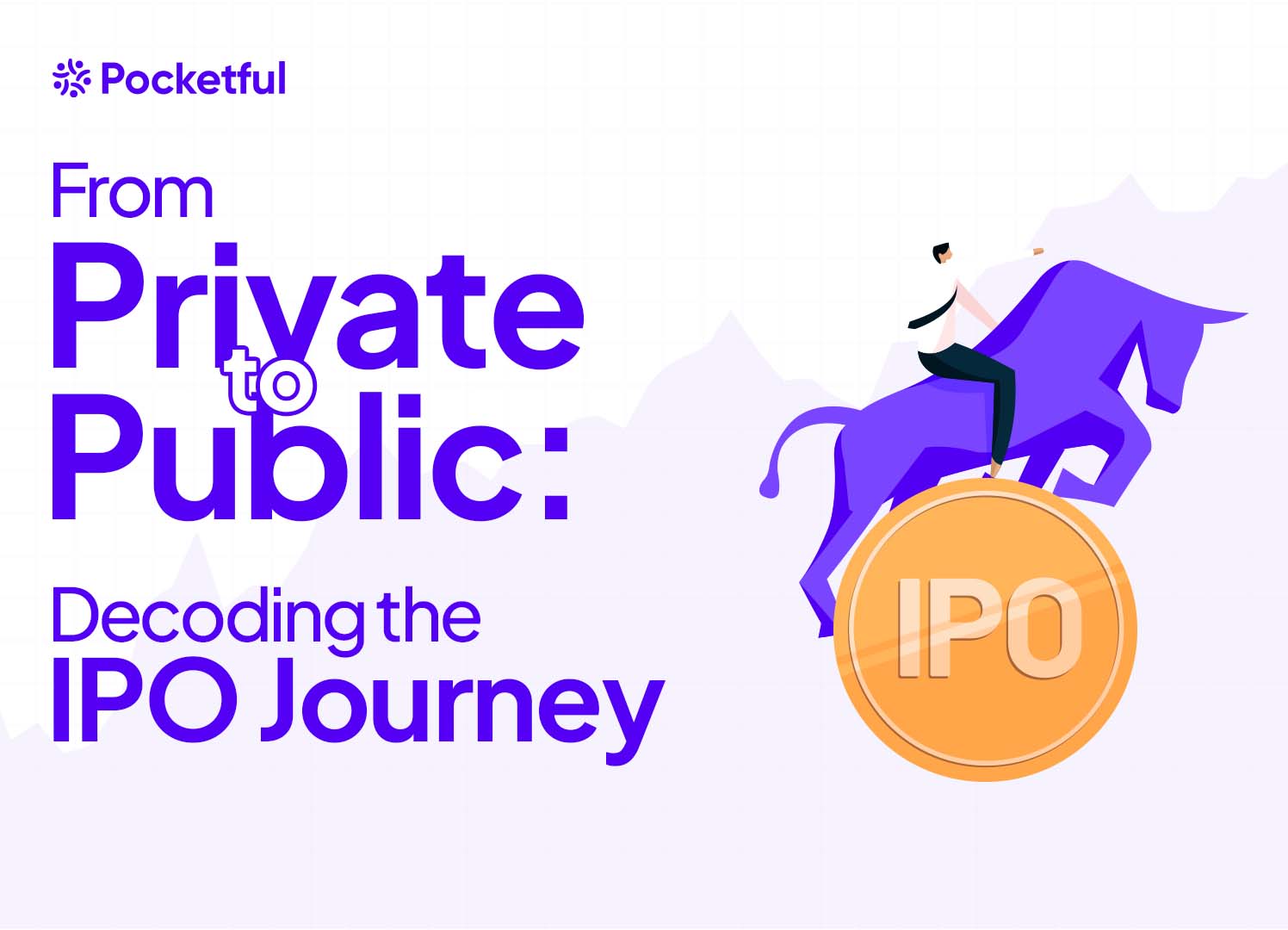| Type | Description | Contributor | Date |
|---|---|---|---|
| Post created | Pocketful Team | Feb-15-24 | |
| Add new links | Nisha | Feb-24-25 |

- Blog
- from private to public decoding the ipo journey
From Private to Public: Decoding the IPO Journey

Visualize this – your once close-knit company, fostered in privacy, is about to step into the arena of the stock exchange. But the path from privacy haven to public spectacle is filled with complex steps and informed decisions.
In today’s blog, we will discover a company’s journey from private to public. This blog will serve as a roadmap to your guide to the IPO procedure.
What is an IPO?
IPO stands for Initial Public Offering. It refers to the process when a private company first sells its shares to the public on the stock exchange. This transforms the company from being privately owned to publicly owned.
Going public through an IPO can be a transformative affair for the company. However, the journey is complex and demands careful planning and execution.
Let’s delve into the key stages of the exciting voyage.
When the company makes its first IPO to the public, the money flows to the company as its share capital and the new shareholders become owners of the company. However, these company shareholders are free to exit their investment anytime.
But before investing in an IPO an investor should keep in mind that not all companies that go public are successful. Some IPOs flop and the company’s stock price might fall after listing.
IPOs can be either SME or Mainboard. Let us have a brief overview.

SME IPO
An SME IPO is a process through which small and medium-sized enterprises (SMEs) can raise funds from the public by issuing shares. SME IPOs are listed on a stock exchange such as BSE, SME, or NSE Emerge.
Eligibility Criteria for an SME IPO
- The company should be a Small and Medium Enterprise as defined by the Ministry of Micro, Small and Medium Enterprises (MSME).
- The company should have a minimum post-issue paid-up capital of INR 1 crore and a maximum of INR 25 crore.
- The company should have a good track record of profits for the last 3 years.
- All SME IPOs should be 100% underwritten* and merchant bankers must underwrite at least 15% of the shares of the SME IPO company.
Note – An underwriter is a professional or institution who analyses and assumes another party’s risk for a fee. Underwriting is a process through which an individual or institution determines and evaluates the risk of a financial agreement.
Mainboard IPO
A mainboard IPO is also known as a mainline IPO. As the name suggests, it is the process by which a large and established company offers its shares to the public for the first time.
Eligibility Criteria for Mainboard IPO
- The company should have a minimum post-issue-paid-up capital of INR 10 crore.
- The company should have a good financial track record with profitable business operations.
- Underwriting is not necessary for a mainboard IPO. However, at least 50% of shares must be subscribed by the qualified institutional buyers (QIB).
Note – QIB or Qualified Institutional Investors are a class of investors with a higher level of financial resources and expertise that meet specific criteria decided by the Securities and Exchange Board of India.
Read Also: Best Smallcap IT Stocks List in India
Steps to take a company public
- The company evaluates its willingness to go public and considers factors like financial statements, growth potential, regulatory compliance and market conditions
- The company needs to partner with experienced advisors that include merchant/investment bankers, lawyers, chartered accountants and public relations specialists.
- The next step is filing the IPO with SEBI, the company drafts the prospectus, a detailed document that is subject to regulatory analysis and outlines the company’s financials, business model, risks, management and promoter details, objects of the issue, capital structure, and dispute, if any.
- The company starts a series of presentations for investors showing its value proposition and growth outlook which is also known as a roadshow.
- A method called Price discovery is used to find the stock’s price based on demand of the IPO. There are two modes of price discovery, which are explained later.
- Your company then officially hits the stock exchange.
Price Discovery
Fixed Price Issue
In the case of a fixed price, the issue price is already selected by the company along with the merchant banker and printed in the offer document before the IPO, and no price discovery mechanism is used.
Note – A merchant banker is a financial institution or an individual who provides a range of services including advisory, capital raising etc. to corporations and governments.
Stages of Fixed Price Issue
- The issuer company collaborates with SEBI-registered intermediaries except for an underwriter.
- The lead manager then files a draft red herring prospectus (DRHP) with the SEBI/Stock Exchange.
- After the successful approval from the SEBI and stock exchange, the issue price and issue period are determined.
- The prospectus is then filed with the Registrar of Companies (ROC).
- Once the issue opens, the investor submits an application form to the intermediary for uploading on the stock exchange platform.
- The issue closes and all the important compliances related to the issue are completed. Securities are finally allocated to the investors at the fixed offer price.
Book-Building Issue
Book Building Process is the more common mode of IPO. Book-building is a process to determine the final price at which the securities will be offered to the public.
Stages in Book-Building
- Company planning to go public appoints the lead merchant bankers as Book Runners. These banks play an important role in the book-building and ensuring a successful offering.
- Investors give their bids to underwriters specifying the quantity of shares.
- Underwriters then input the orders in the electronic book through bidding. The book normally remains open for 5 days.
- The book-running lead managers (BRLM) analyse the bids received and determine the demand at multiple price levels to find the price at which the maximum number of shares can be sold.
Note – BRLM or book-running lead managers play a pivotal role in the IPO procedure. BRLMs conducts due diligence on behalf of the company which involves in-depth analysis of company financials, operations and legal compliance and also helps in setting the offer price.
- The issuer company with the help of book-running lead managers decides on a price band in which investors can bid. The minimum price at which bids can be made is known as the floor price
- Once the bidding period ends, the book is closed and no more bids are accepted.
- Depending on the bids received and the price discovered the lead managers allocate shares after determining the final price.

Benefits of IPO
An IPO can offer various benefits to both the company and the investor.
For Companies
- Helps in raising capital to fund growth initiatives, capital expenditures, acquire other companies, loan repayment and brand awareness.
- Going public allows the shareholders to trade shares on the stock exchange providing liquidity and gains.
- A successful IPO listing can boost a company’s reputation and credibility which will eventually attract new customers.
For Investors
- Adding IPOs to an investment portfolio will help in diversification.
- IPOs offer the opportunity to invest in companies with promising growth potential before they are widely available in the stock market.
IPO v.s. Private Funding
Private funding refers to raising capital for a company from non-public sources, in exchange for equity in the company. It is completely in contrast to public funding which comes from selling shares of the company to the general public through an IPO.
Sources of private funding include firms that invest in early-stage companies with the potential for high returns.
- Angel investors or wealthy investors who invest in companies at their nascent stage.
- Private equity firms, debt financing such as bank loans, crowdfunding i.e., raising smaller amounts of capital online from many individual investors.
Private funding is a suitable option for companies seeking moderate capital for initial growth or specific projects or partnerships with investors who share their vision.
However, the ideal option depends on the company’s goals and stage of development. If the company needs substantial capital for immediate expansion and is comfortable with public analysis, an IPO might be suitable and if a company emphasises flexibility and control, private funding can be a better fit.
Key Considerations for IPO
Launching an IPO is a thrilling journey and demands careful consideration of several factors.
Some of the key considerations are listed below.
- Ensure that the company has a strong financial track record with audited statements. Investors will analyse the financial performance, revenue, and other financial metrics before investing.
- Analysis of ongoing market conditions such as the industry trends and the other upcoming IPOs. Favourable market conditions can increase the chances of a successful debut.
- Clearly express the company’s business model because the investor seeks companies with a compelling story and clear path to future growth.
- Ensure compliance with all relevant legal and regulatory requirements including corporate governance standards, working with legal advisors, etc.
- Investors evaluate the leadership team’s track record. Hence, the companies should have a capable and experienced management team.
- Develop a comprehensive investor relations strategy which includes communication plans, investor education and fostering positive relationships with the investment committee.
- Choose underwriters with good reputations and expertise. Underwriters play an important role in smoothing the IPO procedure.
- Conduct a thorough risk analysis and disclose the potential risks to the investors. Transparent communication about risks will validate a commitment.
Read Also: What is Grey Market Premium (GMP) in IPOs?
Conclusion
The journey from a private company to a public company through an IPO is indeed fascinating, and filled with zeal and strategic decisions. By carefully considering the various aspects and seeking professional supervision, the IPO procedure can influence the power of public markets because an IPO is just the beginning, sustainable growth, and value creation are important for long-term success in the public eye.
Frequently Asked Questions (FAQs)
How long does an IPO generally take?
The average timeline for an IPO is generally 6 to 12 months. Although it can vary depending on company size and complexity.
What are the major costs involved in an IPO?
Investment banking fees, legal fees, accounting and auditing fees, filing and exchange listing fees, and advertising expenses.
How can I invest in an IPO?
Participate in retail allotments by the company through your bank or buy shares on the open market listing.
What happens to employees’ shares after an IPO?
It depends upon agreements and company policies. Some employees may receive restricted stock units or employee stock options.
What happens to the money raised in an IPO?
The company may use the fund for debt repayment, capital expenditure, or research and development.
Disclaimer
The securities, funds, and strategies discussed in this blog are provided for informational purposes only. They do not represent endorsements or recommendations. Investors should conduct their own research and seek professional advice before making any investment decisions.